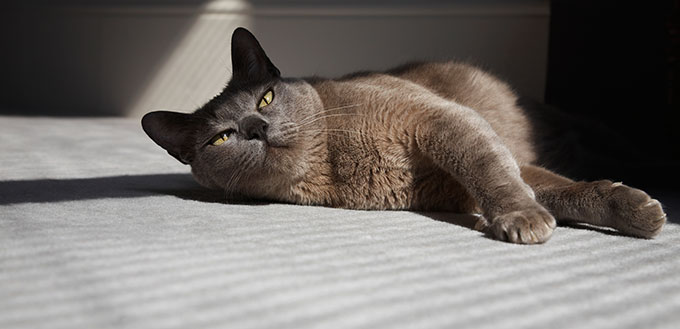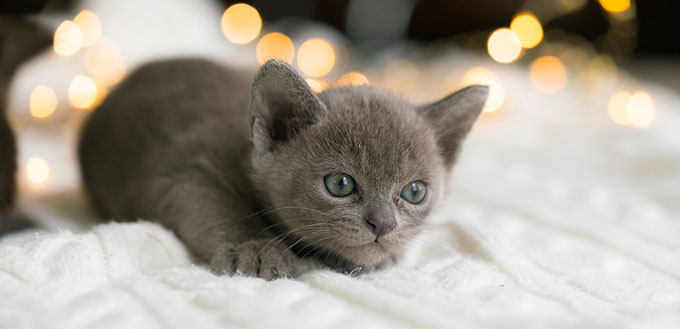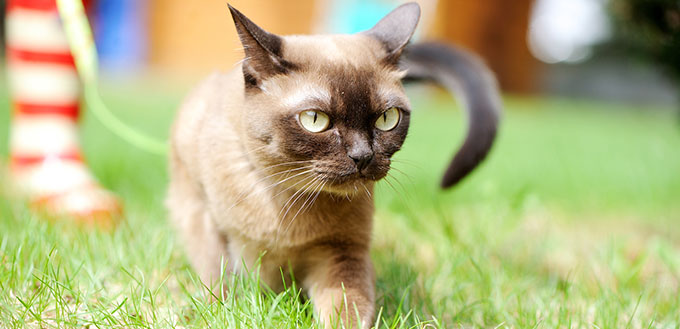Medium sized but with a super-sized personality, the Burmese cat is a head-turning feline that will bring a ray of sunshine into your home. Friendly, loving and just a little bit mischievous, this intelligent breed is also pretty active, making him a good choice for a family cat. Originally from Burma, the breed was used as temple guardians and has a social attitude that you simply cannot ignore.
With its silky short coat and piercing yellow eyes, the Burmese cat is also a looker although he can be quite demanding when it comes to attention and doesn’t really like to be left on his own. We take an in-depth look into this stunning breed to discover why the Burmese could well make the perfect feline pet.
History of the Burmese Cat
With similar looks to the Siamese cat, there’s no denying the elegance and beauty of the Burmese cat. And while today’s Burmese is actually influenced by the Siamese breed, it’s important to look into its origins to really understand this delightful cat.
As its name implies, the Burmese cat originated in Burma, now known as Myanmar, in Southeast Asia. Its ancestor was known as the ‘Copper Cat’ who was thought to have been bred by priests to be a temple and palace cat. Fast forward to 1930, and a cat called Wong Mau, who was a crossbreed of a Burmese type and now considered to be the matriarch of the modern Burmese breed, was acquired by a US doctor, Joseph C. Thompson and transported to the States. Dark brown in color, Wong Mau was initially thought to be a Siamese, but Dr Thompson didn’t agree so bred her with a Seal Point Siamese Cat to see what her offspring would be. While some of her kittens were the lighter color of a pure-bred Siamese, others were much darker so a selective breeding program with the darker hybrid kittens ensued, producing what is today known as the Burmese cat breed. Wong Mau was also to become the matriarch for a later breed, the Tonkinese.
The Burmese breed was initially registered with the Cat Fanciers Association in 1936, but the registration was halted as some breeders were still using Siamese cats. The Burmese cat registration was finally resumed in 1953, setting the stage for the growing popularity of the breed we have today.
Quick Facts About the Burmese Cat
With its gorgeous looks, fun personality and curious nature, the Burmese cat can make a wonderful companion, whether you live on your own or have a busy family. But they do like attention and can be on the demanding side. We dig a little deeper to unearth a few more quick facts about this head-turning kit:
- The Burmese often described as a ‘brick wrapped in silk’! Pick up a Burmese cat and that medium size is deceptive as under the soft fur is a solid, muscular body that is heavier than it looks.
- Although the original Burmese cat was a dark solid brown color (also known as sable), other colors are now recognized by the Cat Fanciers Association, so you can also get a champagne, platinum and blue Burmese cat. They can also come in some tortoiseshell variations.
- The eyes of the Burmese are truly distinctive, coming in slight variations of a rich golden yellow, which is the preferred color for breeders. The Burmese eyes are also very sensitive to intense light.
- Burmese cats are incredible tree climbers and jumpers so they will always need a cat tree or perch to get their jumping fix!
- Even as a grown adult, a Burmese cat will retain some of its kitten tendencies, especially when it comes to playtime. They also thrive on petting and love to have their tummies rubbed.
- Burmese cats are loyal – in fact the breed has been nick-named the dog-cat for their habit of following you around like a puppy dog and their liking for playing a game of fetch.
- Although the Burmese is a very vocal, they don’t have a conventional meow, but rather a guttural raspy rumble sound to get your attention. A contented, petted Burmese will however, emit a very cute soft sound which is almost recognizable as a meow.
Things You Should Know
The life expectancy of a Burmese cat is typical of a pure breed and averages between nine and 13 years. But they tend to ‘age gracefully’ and will often look and behave like a much younger cat, even in their silver years. If you are considering bringing a Burmese into your home, you can expect to pay somewhere between $600-$1,000. This price can be higher depending on the color, with the blue Burmese costing as much as $2,000.
Here are the other essentials you need to know about bringing a Burmese cat into your home:
Health
Thanks to their size and activity levels, the Burmese cat is pretty robust, but it can be prone to quite a few health conditions, so always find out more about the parents if you are buying a new kitten. Here are the main health issues you need to be aware of:
Eye problems: The breed can suffer from certain eye issues, including lipemia of the aqueous humor, which presents as a milky appearance on the eye during kittenhood which usually resolves on its own. They can also develop corneal dermoid, where skin and hair can be present on the surface of the cornea, needing surgery to correct it.
Orofacial pain syndrome: This is an unusual condition which is caused by exaggerated chewing and licking movements, leading to distressing facial pain. Underlying dental issues can trigger the condition so it’s essential to see a vet to get your cat checked out.
Congenital peripheral vestibular disease: This condition is seen in kittens and indicated by head tilting, poor balance, uncoordinated walking and rapid eye movements, with some kits also being deaf.
Hypokalemic polymyopathy: Low levels of potassium in some kittens can lead to muscle weakness, difficulty walking and head tremors. It can be treated with potassium supplements.
Burmese cats are also susceptible to other conditions, including elbow osteoarthritis, enlarged heart and diabetes mellitus.
Feeding
With its muscular build and energetic lifestyle, your Burmese cat needs a diet with a quality protein as the number one ingredient, as well as balanced nutrition to ensure they get all the essential vitamins and minerals they need. But as they are on the stocky side, you need to be aware of portion control to avoid obesity, especially if they are an indoor cat.
The Burmese breed is also known to be picky eaters, so go for taste, with wet canned food that is both flavorsome and easy to eat and digest usually the best option for your cat. And they need constant access to fresh, clean water to maintain their hydration levels.
Care
All-in-all, the Burmese cat is pretty easy to take care of, although there are a few rules you need to follow. Your Burmese can be a bit of a particular cat, especially when it comes to cleanliness and hygiene, so a regularly changed and clean litterbox is essential. You will also need to regularly brush their teeth – so that’s at least once a week – to help prevent gum disease. Check their eyes and ears regularly too, and gently wipe with a dampened soft cotton ball to remove any dirt and debris.
And when it comes to letting your Burmese in or out, although they are robust cats it is advisable to keep your Burmese breed in, to ensure he is safe and happy. Their super-friendly nature makes them an easy target with strangers and as a pure breed, can fall victim to cat theft.
Grooming
The good news about the Burmese is that they do not require excessive grooming as they are able to take care of their soft, short coat themselves. And this is because their fur is not really prone to matting and needs very little cleaning or bathing as it is naturally oiled.
That aside, your kit can actually benefit from a weekly grooming session, not least because it gives him the quality time with his human he will be craving. And regular, gentle grooming with a soft bristled brush can boost their fur and skin health by stimulating blood circulation and helping to evenly distribute their natural oils. You may need to up the grooming briefly come spring, however, as your pet prepares to shed their winter coat.
Temperament
The first thing you will notice about a Burmese cat is just how friendly and affectionate they are, and so make wonderful companions around the home. They are also good with children as they love to play and are robust enough to take a little childlike rough and tumble. And he certainly has a few party tricks up his sleeve, not least his love of fetch, which he will play as if he is from Labrador stock! He also learns quickly and loves new games however, he will expect to be treated with kindness and respect, even from your little ones. He is also likes to be in control, and will settle in with other pets, including dogs as long as they are willing to respect his opinion.
Due to their intelligence, the Burmese can be a little mischievous and can work out how to escape, given half the chance. And as he loves company and attention (it is all about him, after all) he can at times be demanding and will let you know what he wants very clearly. In short, if you love an active cat, that is not shy and wants your attention most of the time, the Burmese is a wonderful cat to have around. But if you would prefer a quieter life and don’t have the energy to keep up with this fun, demanding and playful breed, then the Burmese cat is probably not for you.
Sources:
- About the Burmese – The Cat Fanciers’ Association
- Burmese – International Cat Care
- Burmese Breed – The International Cat Association









